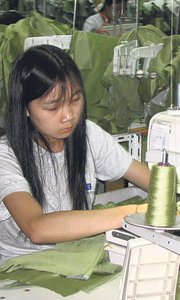Ending the Year With Quota to Spare
U.S. quotas on Chinese apparel and textiles won’t be used up this year
What a difference a year makes
This time last year, clothing manufacturers were fretting that restrictive import quotas on apparel and textiles from China were soon closing up. This summer, nary a sign exists that quotas will be used up before the end of the year.
Meanwhile, industry observers say that apparel quotas on Vietnamese-made goods will be exhausted this fall, a few months before the Southeast Asian country is expected to join the World Trade Organization, an international club of 149 countries that have eliminated quotas on most itemstraded among them.
“People were terrified last year [about producing in China] and were shifting out of China. Vietnam was the next market where you could get good production and pricing. Now, Vietnam is tightening up, and China is wide open,” said Los Angeles customs attorney Richard Wortman, who has seen some of his apparel clients move their production to Vietnam.
Many L.A. apparel manufacturers started making the shift out of China last winter. Dean Wiener, chief operating officer for Stony Apparel, the Los Angeles firm that makes juniors and childrenswear for major department stores around the country, was doing nearly all the company’s production in China. Then he did an about-face. “In June 2005, we decided we couldn’t go to China. I had to set up elsewhere to do production. So last February, we started producing in Guatemala, El Salvador and Honduras,” Wiener said.
Now that quotas are available, the cost for Chinese factories to buy export quotas is declining. So Wiener is headed back to China. “At the beginning of the year, quota prices for a dozen knit tops were $12. Now they have gone down to $3 a dozen,” the operations chief observed. “And Guatemala’s prices are going up because more people are producing there.”
Ron Perilman, president of City Girl Inc., the Los Angeles company that has a collection of misses and contemporary sportswear labels, said other factors were contributing to the decline in China’s popularity. “I’d say about 20 to 25 percent of the industry went elsewhere to protect themselves,” he noted. “The balance of the decline is due to poor lackluster sales due to gas prices. Orders are not what they were. Business is down 10 to 15 percent.”
Perilman, whose company’s annual revenues are more than $35 million, said he kept his production in China because he didn’t have to worry about having to find a factory for his mid-range level of production.
China’s decline also can be attributed to the fact that last year many manufacturers overbought Chinese-made apparel, anticipating that quotas would be imposed in November on 34 categories of textiles and apparel until the end of 2008. The quotas were imposed to protect domestic industry from an onslaught of textile imports from China.
“There was a tremendous glut of apparel on the market,” Perilman said. “If a garment could be bought for $5, people were protecting themselves against safeguards and bringing in 100,000 pieces. Then they would try to sell them when they got here. This year people are ordering much more cautiously.”
That resulted in an 8 percent drop in apparel exports sent from China to the UnitedStates in the first five months of this year. From January to May, China shipped $5 billion in clothing. Meanwhile, apparel exports shipped from Vietnam to the United States are up 29 percent during the same period to $1.2 billion, according to the U.S. Department of Commerce.
Vietnam steps up
Vietnam has slowly been building up its apparel industry since it first signed a bilateral trade agreement with the United States in 2001. A subsequent trade agreement imposed apparel and textile quotas that went into effect in May 2003. The United States is the only country in the world that has imposed quotas on textiles made in that country after apparel and textile exports to the United States grew very quickly.
The current safeguard measures affect 25 apparel and textile categories, from skirts and cotton and synthetic trousers to socks, suit coats and cotton sweaters. The swimwear category is 82.7 percent filled. The skirt category is 67.5 percent filled and is expected to close by Oct. 17. Other categories that are nearly closed include women’s and girls’ woven blouses, men’s and women’s cotton knit shirts, men’s and women’s cotton trousers, men’s and women’s synthetic knit shirts, and underwear.
Vietnam has become increasingly attractive as an apparel producer because the cost to employ workers is less than in China, even though wages are about the same.
“Unlike in China, where a lot of the workers come in from the rural regions and factories have to pay for their dorms, salary, food and healthcare, most of the workers in Vietnam live near the factories. So while wages are about the same in the two countries, in Vietnam you don’t have the added costs,” said Nate Herman, international trade adviser for the American Apparel & Footwear Association, the industry trade organization based in Arlington, Va., that represents some of the largest retailers and manufacturers in the United States.
But quotas may be a thing of the past for Vietnam. The country is expected to join the WTO by perhaps mid-November, which means that those apparel and textile quotas will be dropped. They can be reinstated only if Vietnam continues to subsidize its apparel and textile industry.
The lure of no quotas before the end of the year drew many apparel makers to places such as Ho Chi Minh City, the country’s capital formerly called Saigon. “People knew Vietnam was going to be in the WTO fairly soon,” said New York customs attorney John Pellegrini. “People wanted to place their production there so that when quotas went away, they’d already be established with a factory.”























